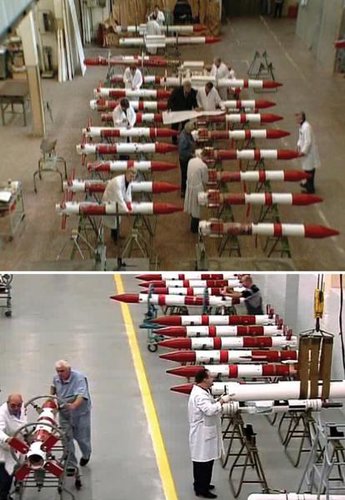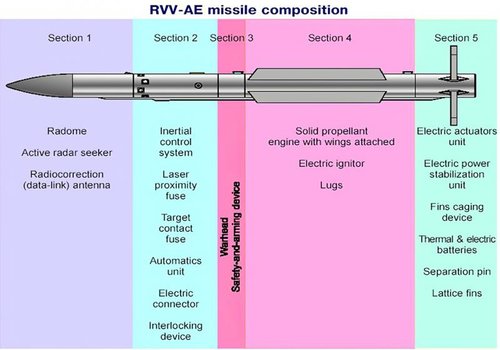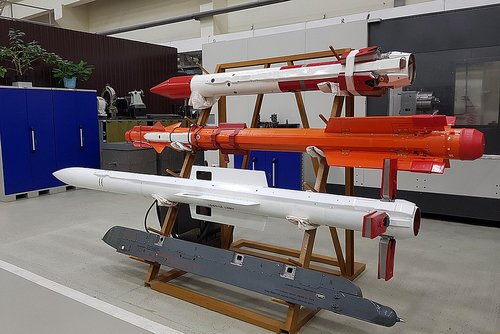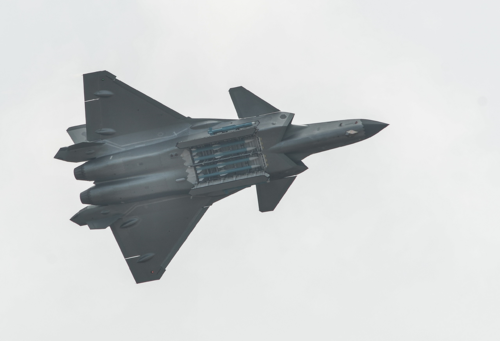You are using an out of date browser. It may not display this or other websites correctly.
You should upgrade or use an alternative browser.
You should upgrade or use an alternative browser.
Current Russian AAM developments
- Thread starter GARGEAN
- Start date
litzj
BLOG : http://jaesan-aero.blogspot.com/
Forest Green
ACCESS: Above Top Secret
- Joined
- 11 June 2019
- Messages
- 9,435
- Reaction score
- 17,183
I guess they take up less space when folded too.
What's this from?
This missile is probably designed for an attritable UCAV.
TAOG
I really should change my personal text
- Joined
- 7 October 2018
- Messages
- 108
- Reaction score
- 237
Nope. It is just a semi-finished product of the regular R-77 missile.
The below picture shows the production line of R-77 which was taken in 2007.
Inside Russia’s Vympel Missile Factory | Aviation Week Network
A short version of the R-77 was called a new air-to-air missile but may be just a stage in the production cycle.

FighterJock
ACCESS: Above Top Secret
- Joined
- 29 October 2007
- Messages
- 5,579
- Reaction score
- 5,896
I think that it will only be a matter of time before the Russians design and develop their own version of the Peregrine or CUDA missile.Nope. It is just a semi-finished product of the regular R-77 missile.
The below picture shows the production line of R-77 which was taken in 2007.
Inside Russia’s Vympel Missile Factory | Aviation Week Network
A short version of the R-77 was called a new air-to-air missile but may be just a stage in the production cycle.aviationweek.com
View attachment 622635
Presumably. It being displayed like that and tail section being different from R-77-1 currently in the making (and being present on same pic) suggests otherwise.Nope. It is just a semi-finished product of the regular R-77 missile.
bring_it_on
I really should change my personal text
- Joined
- 4 July 2013
- Messages
- 3,640
- Reaction score
- 3,758
Could the moderators please move the R-77, Cuda'ski or any non Peregrine related discussion to an appropriate thread please.
- Joined
- 3 June 2011
- Messages
- 18,308
- Reaction score
- 12,141
That makes no sense. Why would they have a stage of production where the grid fins are installed that close to the nose of the missile?Nope. It is just a semi-finished product of the regular R-77 missile.
The below picture shows the production line of R-77 which was taken in 2007.
Inside Russia’s Vympel Missile Factory | Aviation Week Network
A short version of the R-77 was called a new air-to-air missile but may be just a stage in the production cycle.aviationweek.com
View attachment 622635
TAOG
I really should change my personal text
- Joined
- 7 October 2018
- Messages
- 108
- Reaction score
- 237
That makes no sense. Why would they have a stage of production where the grid fins are installed that close to the nose of the missile?
"...However, upon close examination, it is apparent that these are selected sections of the regular RVV-AE missile assembled together, including the seeker, laser proximity fuse section, control system compartment and folding lattice fins. The weapon lacked the central section of the body—including rocket motor and wings—as well as, possibly, the warhead. It is most likely that the missile on display is from a stage in the standard RVV-AE production cycle.
This supposition is strongly supported by how similar “short” missiles can be seen in much older illustrations. Weapons of that type were shown in a large number on the Vympel production line in a 2007 movie marking the company’s anniversary . At that time, Russia had not yet dreamed of internally carried air-to-air missiles. ..."

- Joined
- 9 October 2009
- Messages
- 21,928
- Reaction score
- 13,554
New Russian Lightweight Air-Launched Missile Revealed | Aviation Week Network
The Russian Navy has displayed a model of a new small missile that may be a direct successor to the Kh-25M and a complement to the Kh-38M.
New Russian Lightweight Air-Launched Missile Revealed
Share
Piotr Butowski January 16, 2020

MMM ASP missile
Credit: Russian television
GDANSK, Poland—The Russian Navy displayed a model of a new small missile during a Jan. 9 meeting in Sevastopol attended by Russian President Vladimir Putin.
The Joint Small-sized Modular Aviation Weapon, (Mezhvidovoye Malogabaritnoye Modulnoye Aviatsionnoye Sredstvo Porazheniya, or MMM ASP), according to the descriptive plate on the model, is being made to defeat “fuel depots, manpower, various naval surface targets, strongholds, aircraft and helicopters at the base site.”
If the model displayed by Tactical Missiles Corp. (KTRV) was made on the same scale as the model of the Kh-35UE next to it, then the length of the MMM ASP could be estimated at 3-3.1 meters (10 ft.), with a body diameter of 230-240 mm (9 in.), and weight of 200-220 kg (440-485 lb.). This would make it the smallest air-launched missile in Russia, apart from helicopter anti-tank missiles.
The most widely used tactical missile in Russia, the Kh-25M, has been in service since 1982. It has a length of 3.7 m and weighs 300 kg.
Among the new generation of airborne missiles, the smallest is the Kh-38M, with a launch weight of 520 kg. It can therefore be expected that the MMM ASP (its other designations are unknown at the moment) may become a direct successor to the Kh-25M and a complement to the Kh-38M.
There is no information about the missile’s guidance system. Judging from the term “modular,” the missile seeker is interchangeable between active radar, passive radar and opto-electronic. An additional fairing under the seeker head is visible on the model. The Kh-58UShKE-IIR anti-radar missile presented at MAKS in 2015 was similar. It had an additional thermal imaging sensor to guide the missile to the heat source (for example, a ground radar station) at the terminal stage of flight.
- Joined
- 11 February 2010
- Messages
- 1,643
- Reaction score
- 2,682
- Joined
- 18 May 2019
- Messages
- 640
- Reaction score
- 1,672
- Joined
- 2 January 2006
- Messages
- 3,817
- Reaction score
- 5,021
PL-15 range, FWIW check out Wiki and other sites, is 400km believable?
View attachment 622213
View attachment 622214
Plain wrong and mixing with another missile, the PL-17 ULR-AAM. The PL-15 is said to have a range of 180-200km, what also is not that bad, but surely not 400km.
Look like izd. 180 was finally revealed at MAKS-2021.
Photos (c) Michael Jerdev
View: https://twitter.com/MuxelAero/status/1417540055418159110?ref_src=twsrc%5Etfw
Photos (c) Michael Jerdev
View: https://twitter.com/MuxelAero/status/1417540055418159110?ref_src=twsrc%5Etfw
Similar threads
-
-
-
-
-
Indian Air Force Grounds Russia-Developed Sukhoi-30 Jet Fleet
- Started by Triton
- Replies: 1





